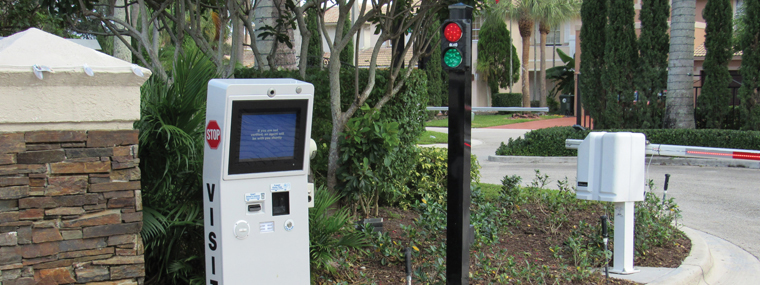
Testing Technology and Paving the Way for Virtual Security in More Communities
By Brie Shouppe / Published March 2020

During its inception in 1997, Joel Meyer watched a community come to life. As an original resident of his neighborhood in Southeast Florida, Meyer has first-hand experience with the development of an association and how it turns over from a developer since he joined as an original board member in 1998. Over the years, there isn’t any doubt that Meyer has witnessed various transformations at his community. One of the more recent changes was an upgraded entrance and accompanying security systems. It may have been years in the making, with a few bumps in the road, but Meyer knows exactly what it took to bring the systems of a development site to modern day technology.
To start, this new community in Coconut Creek had a single point of entry and a single point of exit. One barrier arm in each lane was meant to prevent drivers from entering before stopping at the call box or using a remote control to open the arm. The methods in place didn’t help much, though, according to Meyer. “Gates were being broken left and right” and “traffic was crazy” for residents and visitors trying to enter.
Looking back on it now, Meyer says, “Having a call box is really like having nothing at all. Those codes usually get passed around, and people end up knowing what the code is to get into the community.” Technically, visitors were supposed to scroll through a directory to call a resident, but there were “too many ways to bypass the box and remote entry.”
In an effort to help the system in place, iron gates were added at the entrance as an addition to the barrier arms. However, the problems persisted. The gates would still be broken, and people continued to find ways into the community.
For nearly 20 years, the same set-up was in place. Meyer had left the board in 1999, but in 2016, he had the opportunity to rejoin. Immediately, he says he recognized that the “front entry way needed some help.” With an idea of what he wanted to see for the community, he encouraged other residents to join the board and help take the community in a new direction.
It was time for a change, and the board of directors was ready to get the community “wrapped around a whole new protocol in gaining entry,” says Meyer. So they made the transition to their first virtual guarding system. Unfortunately, the initial experience with this technology did not go as anticipated. Between communication issues and frequently having the gates locked open, the entire system struggled.
Luckily, Meyer was familiar with another virtual gate guard system run by an entirely different company. His brother lived nearby, and he was always impressed by the experience he had when going to visit. Thus, the board began interviewing and researching other virtual security providers to see different technological systems available.
With the budget to make another change, Meyer and the board members decided an entire update of the community entrance could happen. While most of the residents supported the idea, there were a few that proposed building a guard house for on-site personnel. The board was prepared for this, and they knew, “People will get behind you when you present the right argument and reasons for what you’re doing,” says Meyer.
The board decided it was best to provide the community with examples. One visit was made to a community nearby with an on-site guard, but “astronomical” lines would form as visitors tried to enter. Meyer told the residents, “We can speed that up with technology,” and he took many of them to a community with a virtual gate guard that automatically verified permitted visitors as they arrived at the gate.
Aside from what they were able to physically see with different gate security methods, Meyer said the board also realized that it was time to take advantage of newer technology and be the first ones to use advancements. “Technology is here. Whether you like it or not, it’s taking over. Let’s jump on the bandwagon and do what we need to,” says Meyer.
With the new virtual gate guard in place and an upgraded entrance, Meyer says, “It’s a perfect situation.” As visitors arrive, they must insert a state-issued identification card or present a valid QR code at the kiosk. In many cases, the visitors are automatically verified. If they’re not, they are able to speak with a virtual guard who verifies whether or not a visitor is allowed into the community. With the data, video recording, and audio that is captured around the entrance, Meyer says their issues have dramatically decreased; “Having a virtual guard, having somebody see who’s at the gate, what their license plate is, having that video monitored—that’s the key.”
Prior to the new system, Meyer explains he used to spend three or four hours a week just working on the gates. With the evidence and information captured through the system, he is often able to narrow down the visitors and/or households responsible for incidents and recoup damage costs. Once that process became routine, Meyer says people stopped tailgating and hitting the gates. “That is the biggest deterrent,” Meyer says of residents understanding the seriousness of causing any damage and relaying the message to their visitors.
In addition to the gate, the board decided it was time to employ virtual guards for the pool. After upgrading the amenity, it needed to be protected, and the weekly vandalism incidents needed to be halted. The board decided to add access control and active video surveillance.
One of the biggest benefits to the access control system is knowing which residents are going in and out of the pool, according to Meyer. Only authorized community members have the necessary credentials to enter the area. After hours, virtual guards voice down to anyone who enters the amenity. Meyer says, “We haven’t had a single vandalism (incident) going on one year now. That’s scrubbed out 52 weeks of having to deal with the pool. It’s completely gone.”
With the systems in place, Meyer says he can devote more time to working with his security provider on enhancements and beta testing new systems. In his opinion and with knowledge on different virtual security providers, Meyer says the technology is just as important as the company servicing and researching it. “You have to partner with somebody. You have to understand where your vendors are at and where their vision is…(It’s) working with a company that is continuing to do the research to make their technology better.”
He also shares his experience with other communities that are interested in or new to virtual security systems.
In explaining some of the biggest differences between virtual security guards and alternatives, Meyer says it is important to realize that with virtual guarding, “They’re staying alert, staying active, staying engaged and that makes the biggest difference.”
While the journey may have been rocky at times, Meyer and the board members put in the time and research to find a security provider that met the needs of their community. They value the capabilities of technology and increasing knowledge in the field. For Meyer, “It’s the way to go.”
Brie Shouppe
Manager of Business Development & Marketing, Envera Systems
Brie Shouppe is the Manager of Business Development & Marketing for Envera Systems. She works closely with the sales and marketing departments to provide best-in-class service to the communities that Envera works with. Envera Systems is an all-inclusive security provider that focuses on the unique needs of communities through technology-based solutions. Using Virtual Guards located at Envera’s operating center, Envera is able to provide Next Generation Security by verifying visitors, monitoring video, managing community databases, and more. Contact info: (855) 380-1274 or www.EnveraSystems.com.




